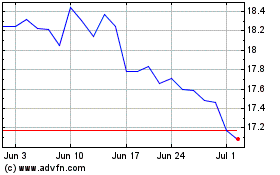By Katherine Blunt and Rebecca Smith
PG&E Corp.'s decision to shut off power to more than two
million Californians this week represents a new reality: It now
plans to pull the plug as a desperation measure whenever its
equipment threatens to spark destructive and potentially deadly
wildfires.
Gov. Gavin Newsom reacted with outrage after PG&E plunged
swaths of Northern California into darkness, saying that the
disruption that ensued shouldn't happen again.
But even as the company was slowly restoring power Friday, a
fast-moving fire in Southern California forced thousands to
evacuate the foothills just outside Los Angeles, underscoring the
danger of wildfires fanned by high winds. Southern California
Edison had shut off power to 20,644 customers by midday Friday,
though by Saturday morning only 870 customers were in the dark.
California's three big investor-owned utilities now have
regulatory permission to cut off power to parts of their service
territories during strong winds to reduce the risk of their
electric lines causing wildfires, after at least 21 fires linked to
utility equipment killed more than 100 people and burned tens of
thousands of homes in recent years.
The Wall Street Journal detailed in April how PG&E intended
to use the outages, known as public safety power shut-offs, to
reduce wildfire risk, a strategy that carries consequences for
medically vulnerable populations who rely on electric devices to
survive, and businesses that could lose customers and
inventory.
Such outages are unlikely to end soon because utilities are
liable under California law for wildfire damage caused by their
equipment, even if they aren't negligent. That makes fires a
serious threat to drive the companies into insolvency.
None have employed the shut-off strategy as bluntly as PG&E,
which is scrambling to trim trees near power lines and upgrade
equipment across its 70,000-square-mile service territory, after a
protracted drought this decade turned millions of acres of forest
into a tinderbox.
PG&E provides gas and electric service to 16 million people,
or roughly one in 20 Americans. It cut power for days this week to
nearly 800,000 homes and businesses across 34 counties, the only
U.S. utility to have ever initiated a weather-related shut-off of
such size and duration. Because the average California household
has 2.96 people, according to census data, the number oaffected
likely exceeded 2 million, though PG&E has not offered a more
precise estimate.
The company trails its peers in technology to track winds and
isolate the areas where equipment is at highest risk of sparking
fires. It is also running far behind on several of its most
important safety efforts, records show, including this year's
tree-trimming campaign, which is less than 50% complete.
For now, it said it would broadly employ shut-offs as a last
resort when it determines that the chance of its equipment sparking
fires is high enough to justify prolonged outages.
"We must have zero risk of a spark," said PG&E Chief
Executive Bill Johnson. "We will very likely have to make this kind
of decision again in the future."
Southern California Edison, part of Edison International, and
San Diego Gas & Electric, a unit of Sempra Energy, have used
shut-offs much more selectively, limiting them to smaller areas
identified as extreme risks.
PG&E has said that the scope of its recent outage was mainly
because of the potential for widespread wind, not its lack of
preparedness. It plans to reduce shut-offs by installing better
monitoring technology on its power lines, but cautions that the
process, like its tree-trimming efforts, will take years.
That timeline doesn't sit well with Mr. Newsom. He rejected the
notion that Californians should accept shut-offs as part of their
lives, saying the company's "greed and mismanagement over the
course of decades" had created conditions that "no state in the
21st century should experience." Mr. Johnson said during a news
conference he hadn't delved into all the governor's claims, but if
he did "he might have some slight disagreements."
Already in bankruptcy, PG&E may have little choice. The
company sought chapter 11 protection in January, citing more than
$30 billion in potential liability costs tied to wildfires. If it
is found liable for another major fire during bankruptcy, it would
further threaten its efforts to put together a viable restructuring
plan, already complicated as it seeks to pay fire victims,
insurance companies and others.
California isn't the only place that has faced a crisis
involving power lines and wind-whipped wildfires. Australia has
grappled with the issue after bush fires on a single day in
February 2009 killed 173 people. A royal commission investigated
the fires and came up with 67 recommendations to reduce risk.
Notably missing from the list: shutting off electricity. The
commission concluded that intentional blackouts create other
public-safety risks and disproportionately affect elderly,
medically dependent and low-income individuals.
In California, PG&E's outage has raised questions about the
role of the state in setting ground rules for shut-offs. Earlier
this month, Mr. Newsom signed a law that will require utilities to
craft more detailed plans.
"I believe PG&E took way too aggressive of a stand to cover
themselves from liability," said state Sen. Bill Dodd, the author
of the legislation, whose wine country home was among those blacked
out this week. "This cannot be allowed to happen again."
Elizaveta Malashenko, deputy executive director for safety
policy at the California Public Utilities Commission, said it has
concerns about PG&E's ability to execute power shut-offs. She
cited the company's constraints in targeting specific power
circuits, as well as its problems providing basic information to
customers.
When PG&E announced plans to cut power this week, its
website crashed and remained out of commission for two days as
residents rushed to check whether they would be affected.
"They can't really, at this point, operationally limit the
impact," Ms. Malashenko said.
As of last month, PG&E had completed only 30% of its pledge
to trim trees along 2,455 miles of power lines, it disclosed in
court filings, in part because it has had difficulty finding enough
workers. And it had removed fewer than 40% of the roughly 50,000
dead or dying trees that threaten to fall into live wires,
according to a presentation to state regulators.
PG&E has been trying to improve its ability to closely
monitor weather throughout its service territory and surgically
shut off power. As of last month, it had installed more than 600
weather stations placed on electric poles to track local wind
speeds and it has installed more than 200 devices to segment its
power lines in a way that enable more targeted shut-offs.
Its monitoring system isn't nearly as precise as the one
employed by San Diego Gas & Electric. SDG&E has installed
190 weather stations as well as segmenting devices on every circuit
to dramatically reduce the number of customers affected during any
given blackout throughout a 4,100-square-mile service territory
roughly 6% the size of PG&E's. On Friday, it had initiated a
shut-off that affected fewer than 400 customers.
SDG&E's efforts began after the 2007 Witch Fire, a
197,000-acre blaze that killed two people and destroyed more than a
thousand homes. California regulators ruled in 2017 that SDG&E
couldn't pass $379 million in costs from the Witch Fire and two
other blazes to its ratepayers. That decision set a precedent that
has greatly increased the financial risk for the state's
utilities.
Caroline Winn, SDG&E's chief operating officer, said that
when the utility first proactively cut power in 2013, it
experienced the sort of backlash PG&E is now facing. It took
years for the company to reconfigure its grid and expand its
weather monitoring network, which now allows its meteorologists to
leverage a decade of data when assessing wildfire risk.
"We had to build that situational awareness," she said. "It has
allowed us to be much more surgical when we do shut-offs."
Write to Katherine Blunt at Katherine.Blunt@wsj.com and Rebecca
Smith at rebecca.smith@wsj.com
(END) Dow Jones Newswires
October 12, 2019 16:05 ET (20:05 GMT)
Copyright (c) 2019 Dow Jones & Company, Inc.
PG&E (NYSE:PCG)
Historical Stock Chart
From Mar 2024 to Apr 2024

PG&E (NYSE:PCG)
Historical Stock Chart
From Apr 2023 to Apr 2024
